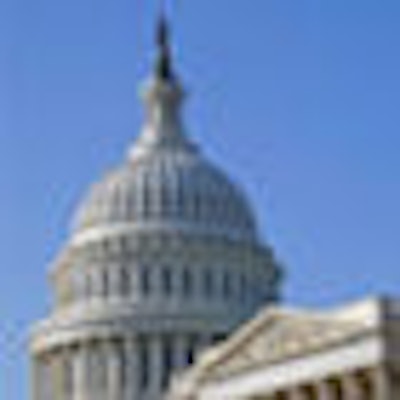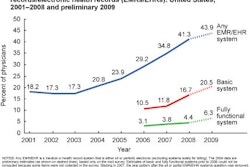
In the midst of a massive governmental healthcare reform effort in the U.S., medical imaging is being squeezed. And it's not just Congress exerting the pressure: It's also an alphabet soup of government agencies with a plethora of proposals for cutting imaging payments.
For many radiology advocates, it can feel like the proverbial sky is falling, with changes coming so fast it's hard to keep track. To get a better lay of the land, AuntMinnie.com has put together a primer on the outstanding issues for radiology going forward into 2010.
Healthcare reform and the SGR
Congress mandated the sustainable growth rate (SGR) as a means of limiting healthcare expenditures by creating a formula for setting physician payment rates in the Medicare Physician Fee Schedule (MPFS) to the gross domestic product. When actual healthcare spending exceeds the estimate for that year, Medicare uses the SGR formula to reduce physician reimbursement for the following year to break even.
While it sounds like a great idea, healthcare industry observers believe that the formula used to develop the SGR is flawed, and Congress each year typically passes legislation to postpone the annual cuts. Because Congress has kicked the problem down the road every year rather than find a permanent solution, the SGR formula now calls for a whopping 21% cut in the SGR's conversion factor, which industry advocates have been fighting to mitigate.
On December 22, President Barack Obama did just that by signing the Department of Defense Appropriations Act, which was advocated by the American Medical Association and included a provision that postponed the SGR cut until March 1, 2010.
But since this temporary solution didn't come until mid-December, CMS had already figured the cut into its fee schedules for 2010. With the freeze, CMS has said it will recalculate the schedule using the 2009 formula, but the delay means the agency won't be paying any bills until late January.
To make things more complicated, if a more permanent fix for the broken SGR formula isn't found and implemented by March 1, CMS will have to again recalculate its fee schedules, this time with the 21.2% cut.
Why wasn't a fix for the SGR included in the healthcare reform bills passed by the Senate and House of Representatives? It's just too expensive, according to Pam Kassing, senior director of health economics and policy at the American College of Radiology (ACR) in Reston, VA.
"Fixing the SGR requires at least $200 billion," she said. "And that pushes the Senate and House bills way over budget. The best the American Medical Association could do was to get the freeze passed via the Defense bill."
As for its next attempt to get the SGR fixed, in all likelihood, another legislative vehicle would be needed. However, if Congress remains in conference or similar negotiations until the end of February, a temporary SGR fix for the remainder of the year might be included in the final healthcare reform package, Kassing said.
Congress, CMS, equipment use and body parts
In its final rule for new MPFS rates published last fall, the CMS imposed steep cuts to radiology payments. For example, the total cut for MRI is between 40% and 50% in the technical component of imaging exams, Kassing said. Since the change is so dramatic, CMS is transitioning it in over four years, so physician practices won't feel the full effect until 2013.
CMS changed the equipment utilization rate from 50% to 90% for all nontherapeutic equipment costing over $1 million (i.e., CT and MRI). But both houses of Congress have since passed healthcare reform bills, and both bills have gentler shifts in the equipment utilization rate; whatever is signed into law will countermand CMS's 90% proposal.
As for the adjustment in the technical component discount on single-session imaging of contiguous body parts, CMS didn't tackle it in its final rule, Kassing said. But the issue is addressed in Congress' two bills, by increasing the reduction from the current 25% to 50%.
"[Both the House and Senate bills] take money out of the Medicare fee schedule program via equipment utilization and contiguous body part cuts and use it for other things -- to the tune of $3 billion over five years," she said.
|
The House is currently reviewing the Senate bill for reconciliation. House Speaker Nancy Pelosi (D-CA) has expressed optimism about the process.
PPIS: Practice expense nightmare
Another confounding factor in the MPFS cuts are changes CMS has set for practice expenses. The American Medical Association (AMA) conducted the Physician Practice Information Survey (PPIS) to update indirect practice cost data for its Socioeconomic Monitoring Survey (SMS), the last of which was performed in 1999. (Indirect costs include overhead costs in the technical component and all of the physician expense RVUs in the professional component, Kassing said.)
In 1999, the SMS negatively affected radiology's physician expense rates per hour; the ACR submitted supplemental data to correct this, and, in 2006, the physician expense per hour rate improved from $68 to $204. The PPIS, however, decreased that figure by 33%, to $135.
The ACR has made numerous comments to CMS about the PPIS, noting that it is not representative of radiology, that its methodology may have hurt specialties with high direct expenses, and that the data collection methods for the survey have not been transparent. ACR suggested that CMS delay the implementation of any changes from the PPIS and use the SMS results in the interim; or, if the PPIS data must be used, blend them with SMS data and transition over four years. CMS agreed to transition over four years.
"This flawed PPIS data is having a huge impact on all of radiology," Kassing said. "It compounds the hit CT and MR are taking: of that 40% to 50% cut in the technical component, only half is from the equipment utilization rate. The other half comes from CMS' use of this practice expense data."
Because the MPFS' equipment utilization rate cuts only affect advanced imaging modalities, other modalities such as dual-energy x-ray absorptiometry, ultrasound, or mammography, will also see cuts as a direct result of this data, Kassing said.
The ACR isn't the only entity up in arms about the PPIS. On December 28, the American College of Cardiology filed suit in U.S. District Court for the Southern District of Florida against the U.S. Department of Health and Human Services (HHS), alleging that severe cuts in the 2010 Medicare Physician Fee Schedule -- due in part to CMS' use of this physician practice data -- will render the practice of cardiology "nonviable and unsustainable." The ACC's complaint alleges that HHS Secretary Kathleen Sebelius unlawfully adopted the payment rates for cardiology services in the 2010 Medicare Physician Fee Schedule based on faulty data.
A funny thing happened on the way to the MPFS
On top of this, CMS has instituted at least 30 new radiology-related CPT codes for 2010, including three for CT colonography; four for coronary CT and CTA; one for cardiac MR with flow, and four bundled myocardial perfusion with wall motion and ejection fraction codes, according to Kassing.
In particular, the bundled myocardial perfusion codes have unintended consequences: There's physician work and practice expense value loss when these codes are bundled, and since CMS sees them as new codes, they take the full brunt of the final rule cuts, fully transitioned at 2013 values. ACR is working to communicate to CMS that these codes should not be considered new, Kassing said.
"The SGR cut and the MPFS cut compound each other," she said. "With myocardial perfusion, for example, it's being hit with a 35% cut at the fully transitioned rate for the fee schedule. And if the SGR conversion cut takes effect in March -- because Congress isn't able to do anything more permanent to fix it -- these codes would take over a 50% hit."
Yet another wrinkle? All the existing CPT codes subject to changes of the MPFS are also subject to the four-year phase in, which is relatively good news, since it spreads out the pain for radiology, according to Kassing. But other specialties like primary care, ophthalmology, and dermatology get a boost from cuts made to radiology.
"There's a fixed amount of money [within the fee schedule], and some specialties' loss is another's gain," Kassing said.
There's no doubt about it: radiology is being severely tested, according to Kassing.
"We have a challenging year ahead of us to work with CMS to get data implemented that accurately reflects the costs of radiology practice and equipment usage," Kassing said. "ACR takes these issues very seriously and we will do all we can to remedy the situation."
By Kate Madden Yee
AuntMinnie.com staff writer
January 11, 2010
Related Reading
White House marshals resources to complete health reform, January 6, 2010
U.S. health bill passes crucial Senate test, December 22, 2009
U.S. agency sees more health spending with reform, December 14, 2009
Senate to begin debate on healthcare overhaul, December 1, 2009
Bundled payments a way to cut U.S. health costs: study, November 13, 2009
Copyright © 2010 AuntMinnie.com




















